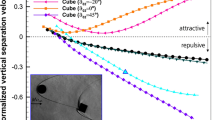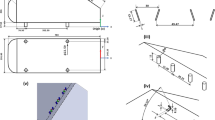Abstract
With the aim to improve the impact initiation capability of a rod-like jet, this paper presents the influence of an axially asymmetric shaped charge on the jet studied by means of numerical simulations. According to Held’s initiation criterion, the impact initiation capability of the jet is affected by the jet tip velocity and diameter. The detonation radius over the longitudinal axis, restricted by the charge radius over the same axis, affects the detonation wave in the charge, the force acting on the liner, and, therefore, the jet velocity and shape. Based on these laws, the structure of the axially asymmetric charge is optimized. Compared with axisymmetric jets, axially asymmetric rod-like jets possess a higher impact initiation capability.
Similar content being viewed by others
References
W. P. Walters and J. A. Zukas, Fundamentals of Shaped Charges (John Wiley and Sons, New York, 1989).
E. L. Baker, A. S. Daniels, J. P. Turci, et al., “Selectable Initiation Shaped Charges,” in Proc. 20th Int. Symp. on Ballistics (2002), pp. 589–596.
R. Fong, W. Ng, and K. Weimann, “Nonaxisymmetric Waveshaped EFP Warheads,” in Proc. 20th Int. Symp. on Ballistics (2002), pp. 582–588.
R. Fong, J. Kraft, L. Thompson, and W. Ng, “3D Hydrocode Analysis of Novel Asymmetrical Warhead,” ADA432103 (2005), pp. 1–4.
G. E. B. Tan, T. K. Lam, and Y. K. Tham, “Planar Cutting Jets from Shaped Charges,” in Proc. 22th Int. Symp. on Ballistics (2005), pp. 507–513.
A. V. Gerasimov, “Formation of a Shaped Charge Jet upon Non-Symmetric Compression of a Shell,” Fiz. Goreniya Vzryva 33 (6), 121–126 (1997) [Combust., Expl., Shock Waves 33 (6), 729–733 (1997)]
L. J. De Chant, “An Analytical Solution for Unsteady, Inviscid Jet Formation due to Asymmetric 2-D Ring Collapse,” Int. J. Impact Eng. 30, 685–698 (2004).
O. Ayisit, “The Influence of Asymmetries in Shaped Charge Performance,” Int. J. Impact Eng. 35, 1399–1404 (2008).
M. Held, “Jet Initiation Phenomena Learned From Australia,” in Proc. 21th Int. Symp. on Ballistics (2004), pp. 27–40.
Y.-D. Li, Sh.-Sh. Feng, and Y.-X. Dong, “Numerical Simulation for Forming High Velocity Shaped Projectile Using Axial Asymmetric Charge,” Acta Armamentar. 31 (Supplement), 55–58 (2010).
C.-B. Li, M.-J. Pei, and Zh.-W. Shen, “Three-Dimensional Numerical Simulation of the High Velocity Rod-Shaped Projectile,” Chin. J. High Pressure Phys. 21(2), 165–172 (2007).
Author information
Authors and Affiliations
Corresponding author
Additional information
__________
Translated from Fizika Goreniya i Vzryva, Vol. 48, No. 6, pp. 64–69, November–December, 2012.
Original Russian Text © Y.-D. Li, Yu.-S. Dong, Sh.-Sh. Feng.
Rights and permissions
About this article
Cite this article
Li, Y.D., Dong, Y.S. & Feng, S.S. Numerical simulation of the influence of an axially asymmetric charge on the impact initiation capability of a rod-like jet. Combust Explos Shock Waves 48, 713–717 (2012). https://doi.org/10.1134/S0010508212060093
Received:
Revised:
Published:
Issue Date:
DOI: https://doi.org/10.1134/S0010508212060093




